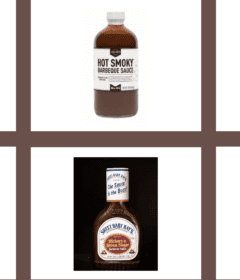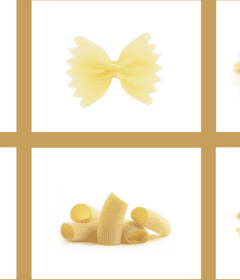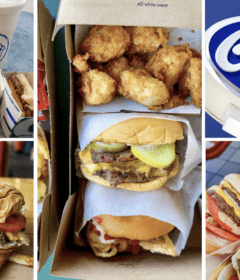Best Charcuterie Board Ideas
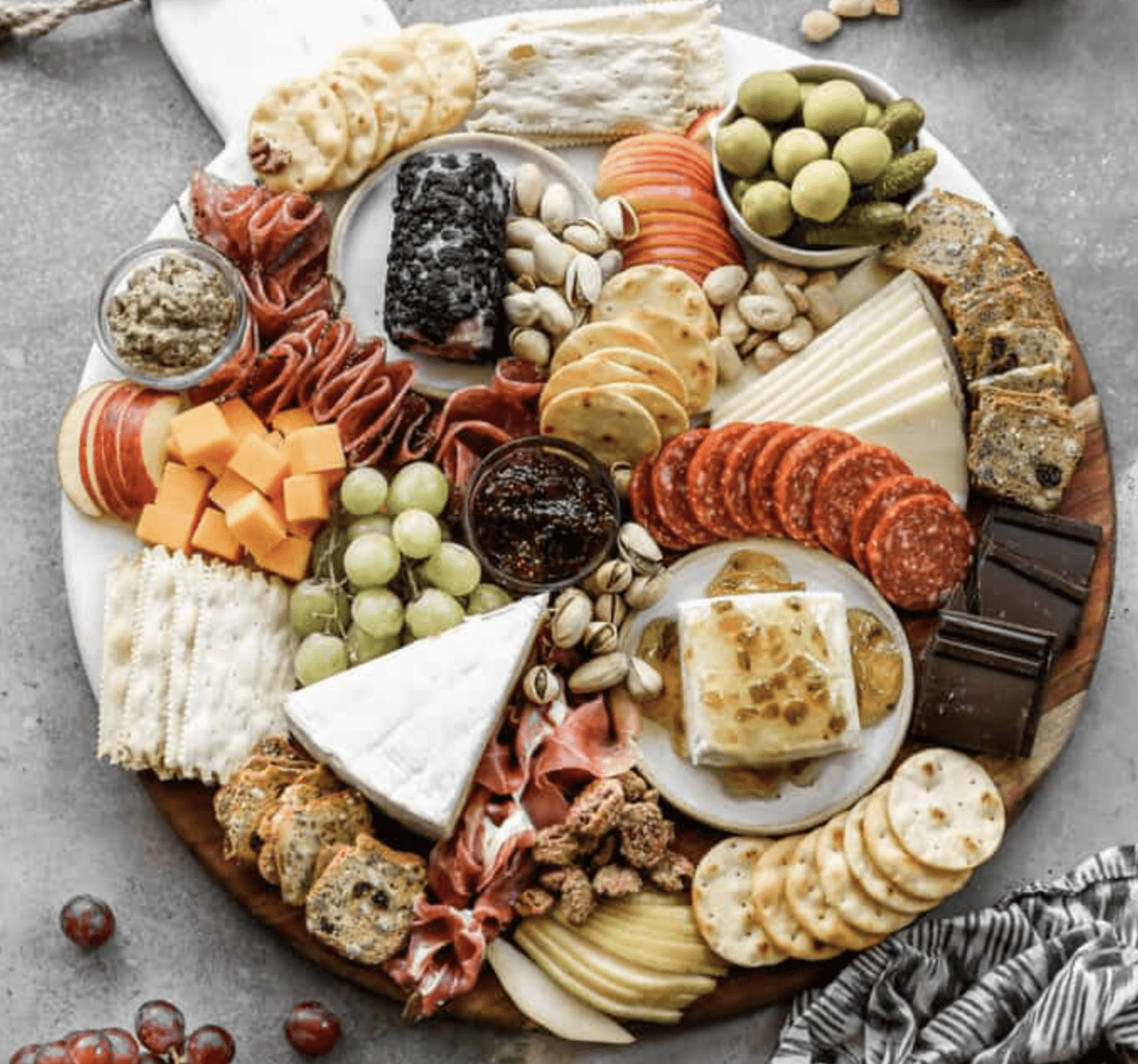
The Best Charcuterie Board Ideas – A charcuterie board is an appetizer typically served on a wooden board or stone slab, either eaten straight from the board itself or portioned onto flatware.
It features a selection of preserved foods, especially cured meats or pâtés, as well as cheeses and crackers or bread.
The Best Charcuterie Board Ideas – The word “charcuterie” refers to cold cooked, cured, or smoked meats, so in the most “official” sense, a traditional charcuterie board is just a meat platter.
But as these craveable boards have gotten more popular for entertaining at home, the everyday definition has expanded to include abundant displays of meats, cheeses, dried and fresh fruits and vegetables, toasted nuts, briny olives, and complementary condiments – honeys, jams, jellies, chutneys, mustards and more!
The Best Charcuterie Board Ideas – A beautiful charcuterie board is a statement piece and a time-saver, since it typically requires little to no cooking.
A charcuterie board can be left out for grazing for up to 2 hours.
Best Charcuterie Board Ideas How Much Food is Required on a Charcuterie Board?
It’s important to remember that your board is an appetizer, not a main course.
Meat: Two to three slices of meat, or approximately 2 to 3 ounces per person should satisfy your guests ahead of the rest of the meal.
Per-pound prices might give you sticker shock, but many are best sliced wafer thin, so a few ounces go a long way.
If you’re serving 8 – 10 people, you will need 1 – 1 1/2 lbs of meat, and you’ll want to pick at least one from each category (more on that below) .
Cheese: It’s usually sliced a little thicker, so 3 ounces of cheese per person or 1 1/2 – 1 3/4 pounds in total for 8-10 people (roughly 3 medium-size hunks) should do the trick.
Extras: You’ll want at least one cracker or piece of bread for every slice of meat.
Extras — pickles, spreads, nuts, fruits — should all be plentiful.
If you want to serve your board as the main dish, add a little extra of everything and think about adding a salad and a heartier cured meat, like a grilled kielbasa or other smoked sausage.
The Best Charcuterie Board Ideas – Meats
There are as many types of cured meats in the world as there are stars in the sky.
Curing is an ancient method to preserve protein for later consumption, and the many various regions and cultures around the world have their own styles of charcuterie — even unique breeds of livestock from which the meats are made.
Here are a few of the major groups you should pull from:
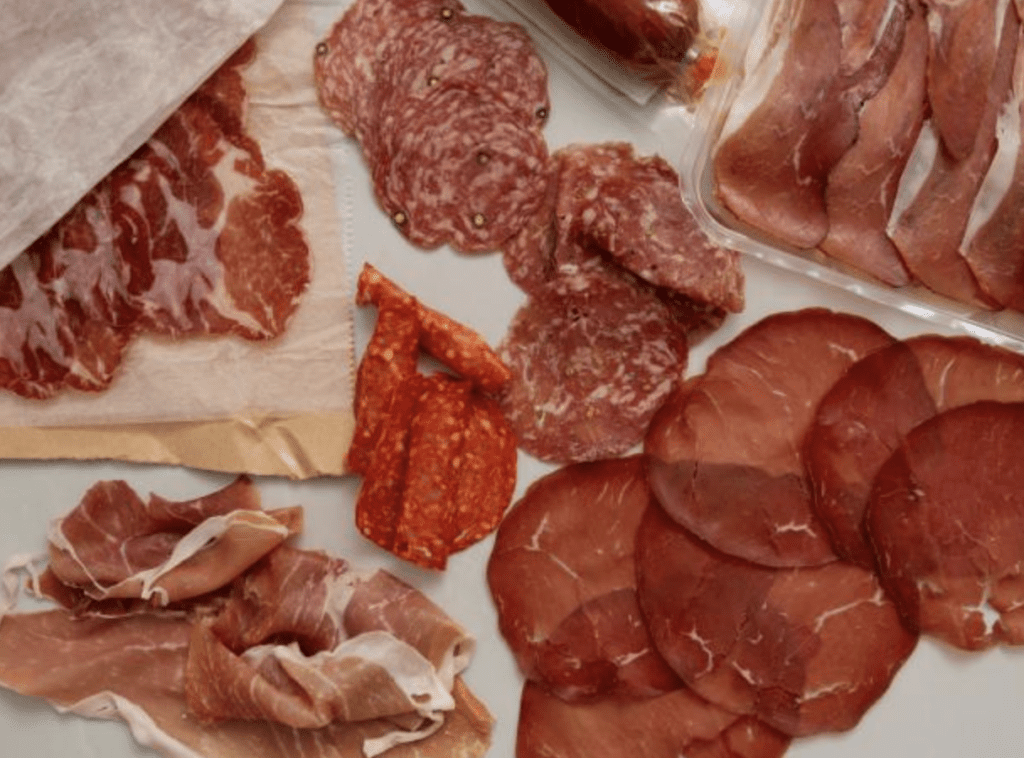
The Best Charcuterie Board Ideas – Meats
The Best Meats for a Charcuterie Board – Dry-Cured Pork
Thin-sliced, fatty and salty, dry-cured pork is a must.
Serrano ham, prosciutto, country ham, Iberico ham, capicola and speck are all readily available.
Look for meat that is pink or red in hue (not brown or gray) with fat that is white (not transparent or opalescent).
Get all meats and cheese sliced fresh from the deli.
The Best Meats for a Charcuterie Board – Bresaola
Like prosciutto, bresaola is also dried and cured, but instead of pork, it’s usually made from beef top round, lending it a deeper flavor and more toothsome texture.
Look for thin slices, a deep reddish color, and a texture that is not overly dry or cracked.
The Best Meats for a Charcuterie Board – Salami
Salami is possibly the most versatile and varied.
It’s an aged sausage made from ground meat seasoned with a variety of herbs, spices and alliums, then dried and fermented in several styles (like soppressata, finocchiona, Genoa).
Smaller salami is best served in thicker slices, while larger ones are best shaved thin.
It should be vibrant in color when sliced, and if you decide to allow guests to cleave off their own, make sure it’s not too hard to cut.
The Best Meats for a Charcuterie Board – Other Additions
Mortadella is a cooked Italian sausage similar to American bologna, sometimes studded with pistachios.
It’s very tender, without the chew of other cured meats.
And you might also delve into meat spreads, rillettes and patés.
Rillettes (meat slow-cooked in fat until it reaches a spreadable consistency) and patés (finely ground meat fortified with ingredients like sauterne, truffles, and spices) make are decadent layered on crostini with mustard and pickles.
‘Nduja is a spicy Italian meat spread — great on a crisp cracker topped with a piece of sharp cheese.
Choose one meat from each category — for example, a nice variety might include prosciutto, capicola, bresaola, soppressata, and mortadella.
You can buy an equal amount of each or play with proportions if you enjoy one more than the other.
The Best Charcuterie Board Ideas – Cheeses
The cheese is here to complement the meat.
Assemble some contrasting textures and flavors: a soft, mild cheese is not going to be the best with soft, mild mortadella, so choose a firm or hard variety of cheese instead.
Salamis work well with creamy companions, and prosciutto benefits from burrata or brie.
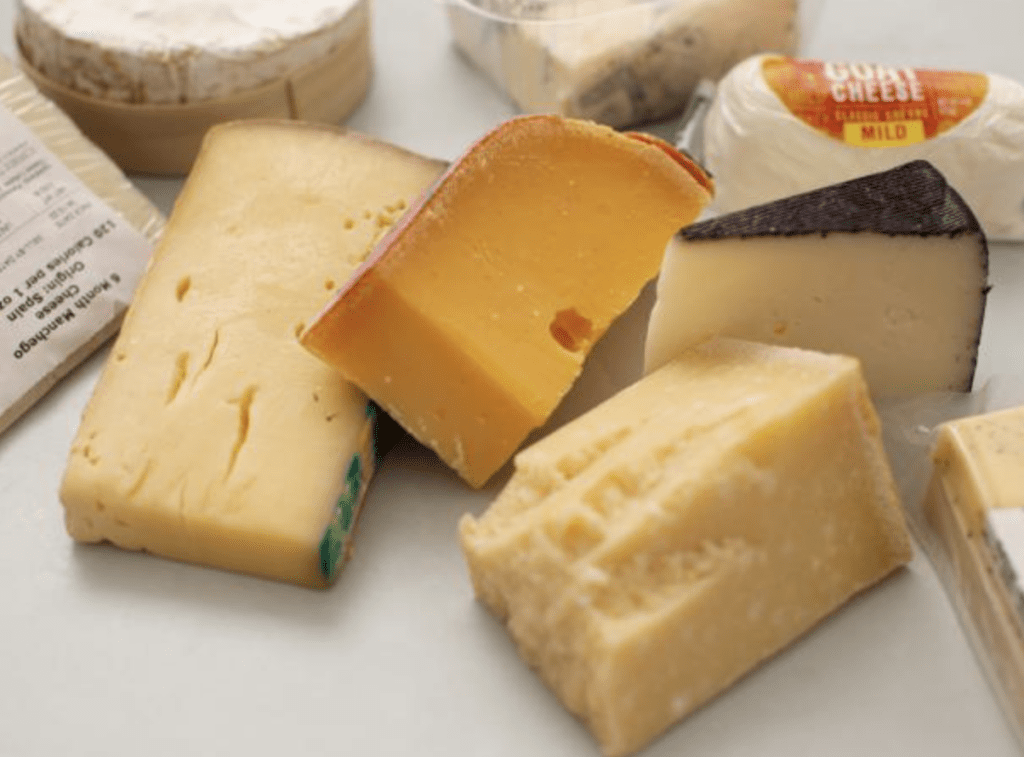
The Best Charcuterie Board Ideas – Cheeses
The Best Cheeses for a Charcuterie Board – Soft Cheeses
Brie, Camembert, triple-cream, burrata, goat cheese, fresh ricotta, Gorgonzola dolce.
These spreadable cheeses lend tons of flavor and buttery texture.
The Best Cheeses for a Charcuterie Board –Semi-Soft Cheeses
Drunken goat, fontina, Muenster, Roquefort, Havarti, Mt. Tam Tripe Cream.
These land in the sweet spot between soft and firm, and they are easy to slice on a board.
They’re creamy, but not gooey, and are mild in firmness and flavor.
Fontina is perfect to mellow out a thick slice of spicy salami.
The Best Cheeses for a Charcuterie Board – Firm Cheeses
Cheddar, Gouda, Gruyère, Stilton, Jarlsberg, Manchego.
These cheeses can hold their own in flavor, and a slice will be stiff enough to top and eat without a cracker.
Though still creamy like a semi-soft, the firm cheeses offer a little more funk and flavor.
Grassy gruyere uplifts ribbony, salty prosciutto.
The Best Cheeses for a Charcuterie Board – Hard
Parmigiano-Reggiano, Pecorino-Romano, Asiago, Mimolette.
These dry, salty, crystalized cheeses work well broken into hunks or pre-sliced and bring out the best in fatty cuts like soppressata or bresaola.
Cheese is usually sliced much thicker than meat, both by the store and by your guests, so you’ll need a little more than the meat.
So pick one cheese from each category, but don’t sweat if you want fewer than four cheeses.
Even if you only choose two, that just leaves more room for bread, grapes and other extras.
The Best Charcuterie Board Ideas – Extras
The meat and cheeses are the stars, but don’t skimp on the filler — this is where the board gets fun.
Not only fruit, spreads, nuts and pickles usually cheaper than meats and cheeses, but they also satisfy hungry guests.
They make the board last longer and keep people happily munching throughout the party.
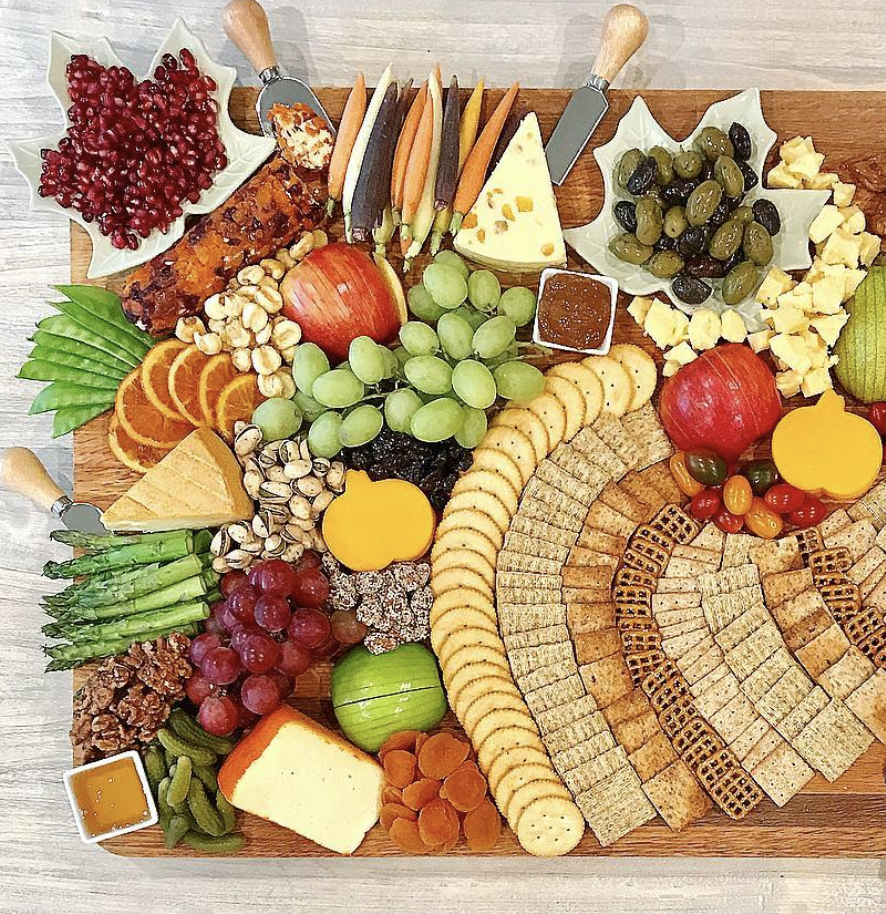
The Best Extras for a Charcuterie Board
The Best Extras for a Charcuterie Board – Nuts
Spiced nuts, candied nuts, Marcona almonds, roasted nuts, nut brittle.
Pick up some candied nuts at the store, but even plain roasted nuts are great, crunchy additions.
The Best Extras for a Charcuterie Board -Fruit
Grapes, sliced apples and pears, dried apricots, dried cranberries, dried and fresh figs.
Apples are delicious and are a great cracker substitute for almost any bite.
Grapes are a favorite on a charcuterie board for a reason — they don’t oxidize, they are fine room temperature, and they love meat and cheese flavors.
And don’t forget seasonal fruits; in late summer peaches and melon are a revelation with prosciutto and brie.
The Best Extras for a Charcuterie Board – Spreads
Honey, mustard, fig jam, membrillo (quince paste), pepper jelly, sweet or savory chutneys, tapenades.
The fun is in experimenting with flavor combos.
The Best Extras for a Charcuterie Board – Pickled/Briny
Brined or oil-cured olives, cornichons, caper berries, marinated artichokes, roasted red peppers and pickled vegetables.
These create delightful contrast to the fattier flavors.
You can borrow from the Italian antipasto with artichokes and red peppers or dabble in a southern style with bread and butter pickles and pickled okra.
The Best Charcuterie Board Ideas – Presentation
Place each type of meat on a different section of a large serving board.
To make the slices easy to grab and visually interesting, fold and shape them in a variety of ways.
You can make rosettes by folding pieces of meat in half and then rolling each up like a cigar.
Pinch the cured ham into little mounds or arrange in swirls.
Salamis can be rolled or folded into quarters and stretched across a section of the board in little “rivers.”
Add the spreads to the board next, either mounded directly on the board or in small containers or on plates with a broad knife for spreading.
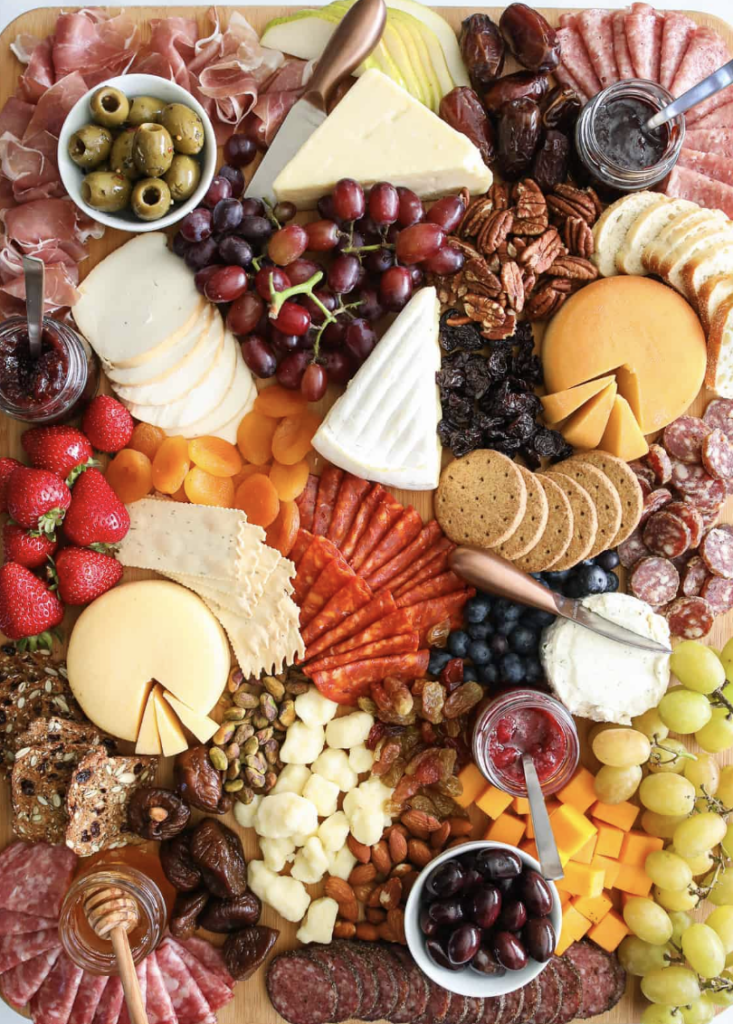
The Best Presentation for a Charcuterie Board
Divide the cheeses among the sections, pairing them with the meats and spreads to contrast flavors and textures.
Experiment with combinations.
Try a creamy burrata or Brie as a companion to salty-sweet prosciutto; match a firm or hard cheese like asiago with a soft, mild mortadella; place a mild buttery fontina with a spicy salami to mellow it out.
To encourage noshing, break the hard cheese into large shards, cut a wedge or two from a full wheel and slice some of the bigger blocks into easy-to-grab pieces.
Pour the honey into a small glass jar or bowl, sprinkle in a pinch of crushed red pepper flakes and nestle it among the meats and cheeses with a little spoon for serving.
Place the quince paste on a small plate or cutting board and the fig jam in a small bowl and place them among the meats.
Arrange bundles of grapes near the saltier cheeses.
Put the pickled vegetables, cornichons and mustard in separate small bowls and add them to the board.
Fill in some the empty spaces with piles of nuts and apricots.
Plug other blank spots with the figs or other fresh fruit.
Fill in any remaining spaces with the baguette pieces, crostini, crisps and crackers, then put any remaining in a separate dish or basket.
Serve the board at room temperature with an assortment of knives for cutting and spreading, small forks for spearing and spoons for drizzling and scooping.
The board can sit at room temperature for up to 2 hours.
Italian Hoagie – Sausage – Peppers >>
Italian Hoagie – Sausage – Peppers >>
Amazing Appetizers From The Best Chefs >>

